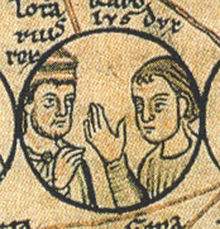Charles, Duke of Lower Lorraine
| Charles, Duke of Lower Lorraine | |
|---|---|

Charles and his brother Lothair of France
|
|
| Spouse(s) | Adelaide of Troyes Adelaide, the daughter of a vassal of Hugh Capet possibly Bonne, the daughter of Godfrey I, Count of Verdun |
| Noble family | Carolingian |
| Father | Louis IV of France |
| Mother | Gerberga of Saxony |
| Born | 953 Laon |
| Died | 993 Orléans |
Charles (953–993) was the Duke of Lower Lorraine from 977 until his death.
Born at Reims in the summer of 953, Charles was the son of Louis IV of France and Gerberga of Saxony and the younger brother of King Lothair. He was a sixth generation descendant of Charlemagne. When his father was captured by the Normans and held, both his sons were demanded as ransom for his release. Queen Gerberga would only send Charles, who was then handed over and his father was released into the custody of Hugh Capet.
In or before 976, he accused Lothair's wife, Emma, daughter of Lothair II of Italy, of infidelity with Adalberon, Bishop of Laon. The council of Sainte-Macre at Fismes (near Reims) exonerated the queen and the bishop, but Charles maintained his claim and was driven from the kingdom, finding refuge at the court of his cousin, Otto II. Otto promised to crown Charles as soon as Lothair was out of the way and Charles paid him homage, receiving back Lower Lorraine.
In August 978, Lothair invaded Germany and captured the imperial capital of Aachen, but failed to capture either Otto or Charles. In October, Otto and Charles in turn invaded France, devastating the land around Rheims, Soissons, and Laon. In the latter city, the chief seat of the kings of France, Charles was crowned by Theodoric I, Bishop of Metz. Lothair fled to Paris and was there besieged. But a relief army of Hugh Capet's forced Otto and Charles to lift the siege on 30 November. Lothair and Capet, the tables turned once more, chased the German king and his liege back to Aachen and retook Laon.
Around 979, Charles transferred the relics of Saint Gudula from Moorsel to the Saint Gaugericus chapel in Brussels. This is generally accepted as the time when the city was founded. Charles would construct the first permanent fortification in the city, doing so on that same island.
...
Wikipedia
